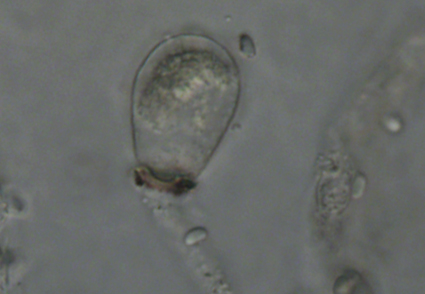Abstract
A new genus and species in the Mucoromycota, Mooraboolomyces wintlei, was isolated into culture from leaf litter from a national park in Victoria, Australia, and is described. The strain reproduced asexually to form sporangia and sporangiospores, with no production of zygospores, and sequencing of its genome and analysis supported a heterothallic mode of reproduction. Phylogenetic analyses using five DNA regions placed the strain within the Mucorales and Mucoraceae, clearly distinct from previously described genera. This represents the second genus in this phylum that has been identified from Australia and that is currently unique to this country.
References
- Afgan, E., Baker, D., Batut, B., van den Beek, M., Bouvier, D., Čech, M., Chilton, J., Clements, D., Coraor, N., Grüning, B.A., Guerler, A., Hillman-Jackson, J., Hiltemann, S., Jalili, V., Rasche, H., Soranzo, N., Goecks, J., Taylor, J., Nekrutenko, A. & Blankenberg, D. (2018) The Galaxy platform for accessible, reproducible and collaborative biomedical analyses: 2018 update. Nucleic Acids Research 46: W537–W544. https://doi.org/10.1093/nar/gky379
- Galindo, L.J., López-García, P., Torruella, G., Karpov, S. & Moreira, D. (2021) Phylogenomics of a new fungal phylum reveals multiple waves of reductive evolution across Holomycota. Nature Communications 12: 4973. https://doi.org/10.1038/s41467-021-25308-w
- Hoffmann, K., Pawlowska, J., Walther, G., Wrzosek, M., de Hoog, G.S., Benny, G.L., Kirk, P.M. & Voigt, K. (2013) The family structure of the Mucorales: a synoptic revision based on comprehensive multigene-genealogies. Persoonia 30: 57–76. https://doi.org/10.3767/003158513X666259
- Kornerup, A. & Wanscher, J.H. (1978) Methuen Handbook of Colour. London: Erye Methuen, 252 pp.
- Merényi, Z., Krizsán, K., Sahu, N., Liu, X.-B., Bálint, B., Stajich, J.E., Spatafora, J.W. & Nagy, L.G. (2023) Genomes of fungi and relatives reveal delayed loss of ancestral gene families and evolution of key fungal traits. Nature Ecology and Evolution 7: 1221–1231. https://doi.org/10.1038/s41559-023-02095-9
- Niskanen, T., Lücking, R., Dahlberg, A., Gaya, E., Suz, L.M., Mikryukov, V., Liimatainen, K., Druzhinina, I., Westrip, J.R.S., Mueller, G.M., Martins-Cunha, K., Kirk, P., Tedersoo, L. & Antonelli, A. (2023) Pushing the frontiers of biodiversity research: unveiling the global diversity, distribution, and conservation of fungi. Annual Review of Environment and Resources 48: 149–176. https://doi.org/10.1146/annurev-environ-112621-090937
- Pitkin, J.W., Panaccione, D.G. & Walton, J.D. (1996) A putative cyclic peptide efflux pump encoded by the TOXA gene of the plant-pathogenic fungus Cochliobolus carbonum. Microbiology 142: 1557–1565. https://doi.org/10.1099/13500872-142-6-1557
- Schwarz, P., Lortholary, O., Dromer, F. & Dannaoui, E. (2007) Carbon assimilation profiles as a tool for identification of zygomycetes. Journal of Clinical Microbiology 45: 1433–1439. https://doi.org/10.1128/JCM.02219-06
- Shipton, W.A. & Schipper, M.A.A. (1975) Halteromyces, a new genus in the Mucorales. Antonie van Leeuwenhoek 41: 337–342. https://doi.org/10.1007/BF02565068
- Tamura, K., Stecher, G. & Kumar, S. (2021) MEGA11: Molecular Evolutionary Genetics Analysis version 11. Molecular Biolgy and Evolution 38: 3022–3027. https://doi.org/10.1093/molbev/msab120
- Urquhart, A.S., Douch, J.K., Heafield, T.A., Buddie, A.G. & Idnurm, A. (2021) Diversity of Backusella (Mucoromycotina) in south-eastern Australia revealed through polyphasic taxonomy. Persoonia 46: 1–25. https://doi.org/10.3767/persoonia.2021.46.01
- Voigt, K. & Wöstemeyer, J. (2001) Phylogeny and origin of 82 zygomycetes from all 54 genera of the Mucorales and Mortierellales based on combined analysis of actin and translation elongation factor EF-1alpha genes. Gene 270: 113–120. https://doi.org/10.1016/s0378-1119(01)00464-4
- Voigt, K., James, T.Y., Kirk, P.M., Santiago, A.L.C.M.d.A., Waldman, B., Griffith, G.W., Fu, M., Radek, R., Strassert, J.F.H., Wurzbacher, C., Jerônimo, G.H., Simmons, D.R., Seto, K., Gentekaki, E., Hurdeal, V.G., Hyde, K.D., Nguyen, T.T.T. & Lee, H.B. (2021) Early-diverging fungal phyla: taxonomy, species concept, ecology, distribution, anthropogenic impact, and novel phylogenetic proposals. Fungal Diversity 109: 59–98. https://doi.org/10.1007/s13225-021-00480-y
- Zerbino, D.R. & Birney, E. (2008) Velvet: algorithms for de novo short read assembly using de Bruijn graphs. Genome Research 18: 821–829. https://doi.org/10.1101/gr.074492.107
- Zhao, H., Nie, Y., Zong, T.-K., Wang, K., Lv, M.-L., Cui, Y.-J., Tohtirjap, A., Chen, J.-J., Zhao, C.-L., Wu, F., Cui, B.-K., Yuan, Y., Dai, Y.-C. & Liu, X.-Y. (2023) Species diversity, updated classification and divergence times of the phylum Mucoromycota. Fungal Diversity 123: 49–157. https://doi.org/10.1007/s13225-023-00525-4


